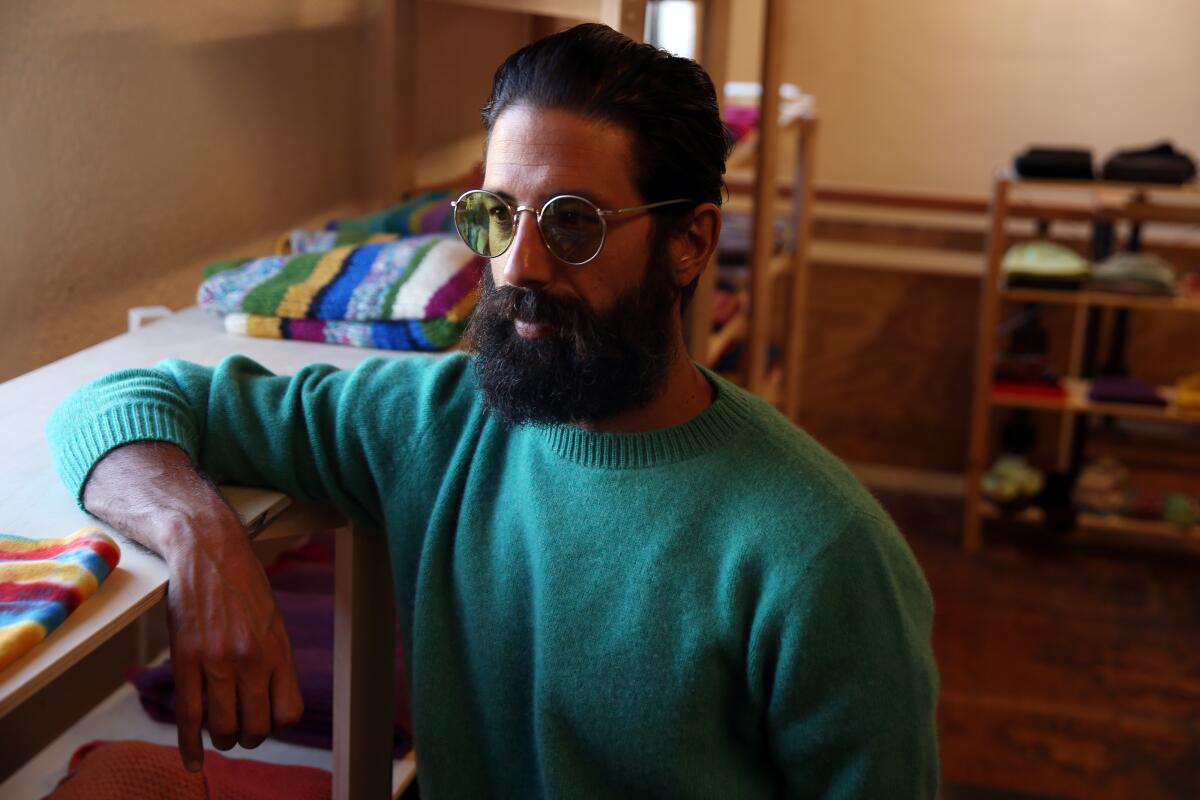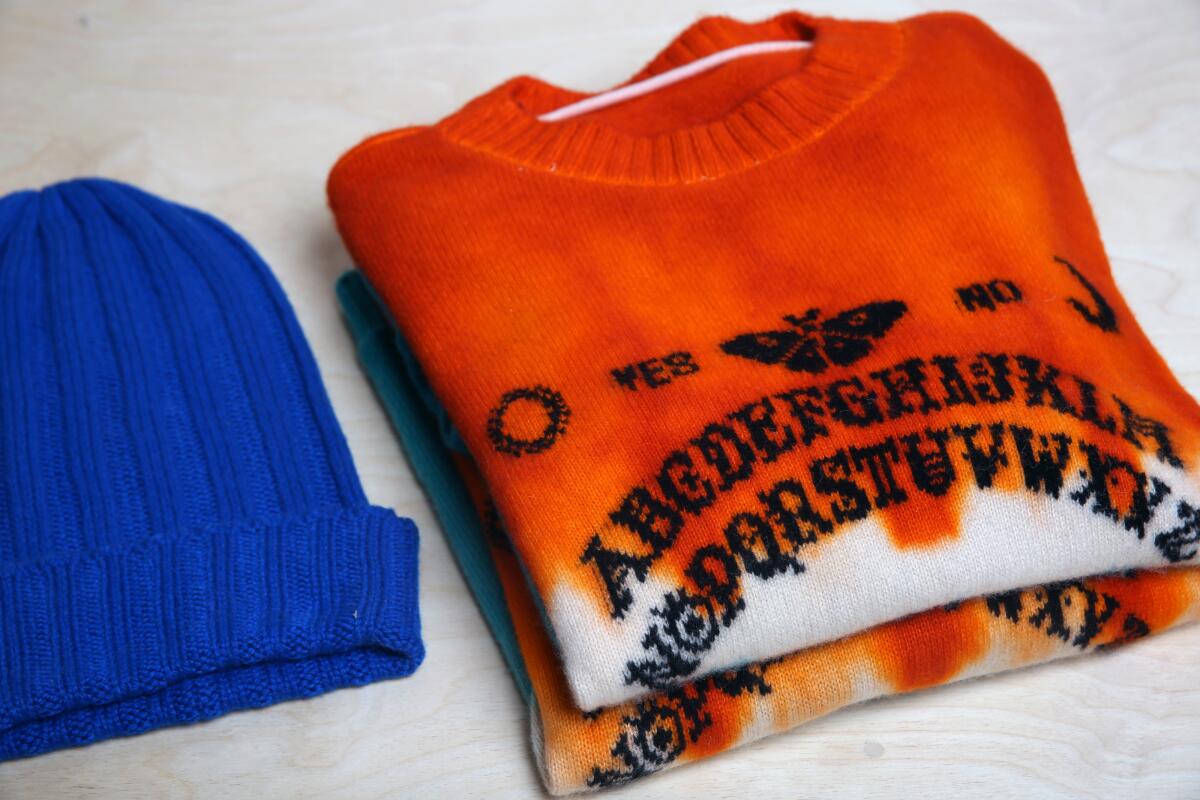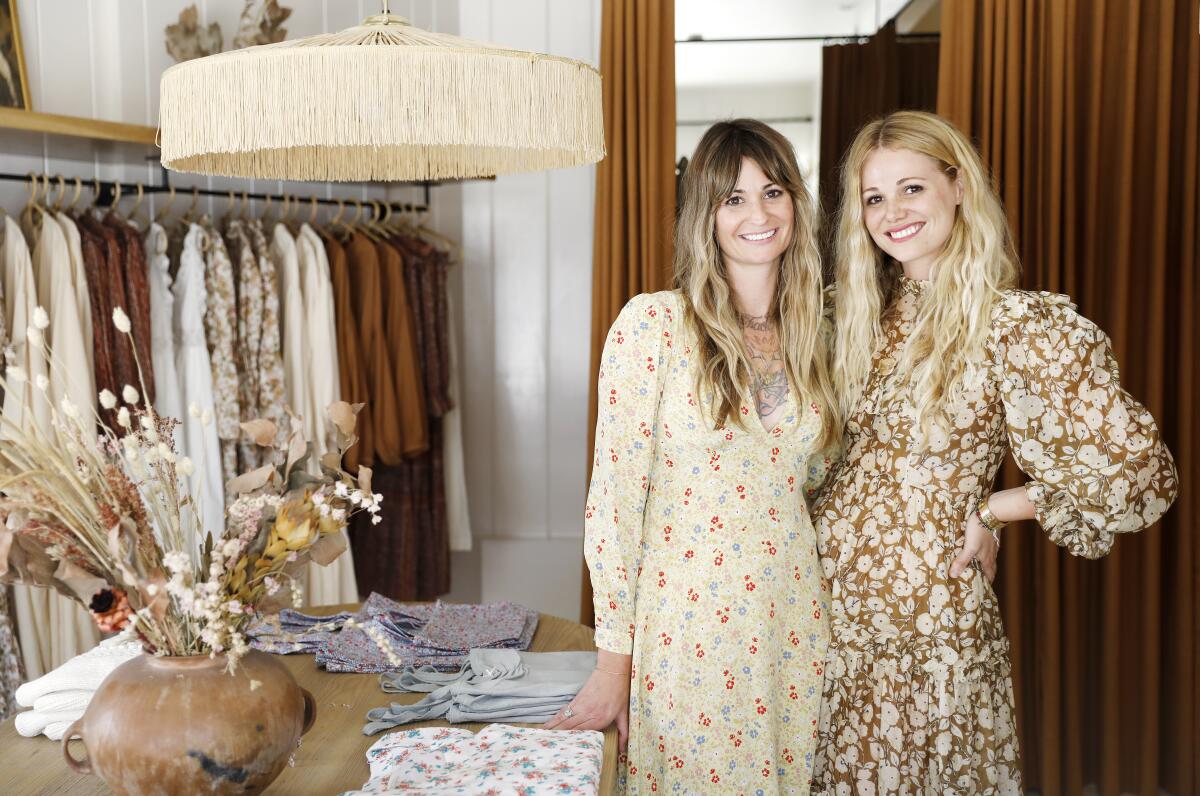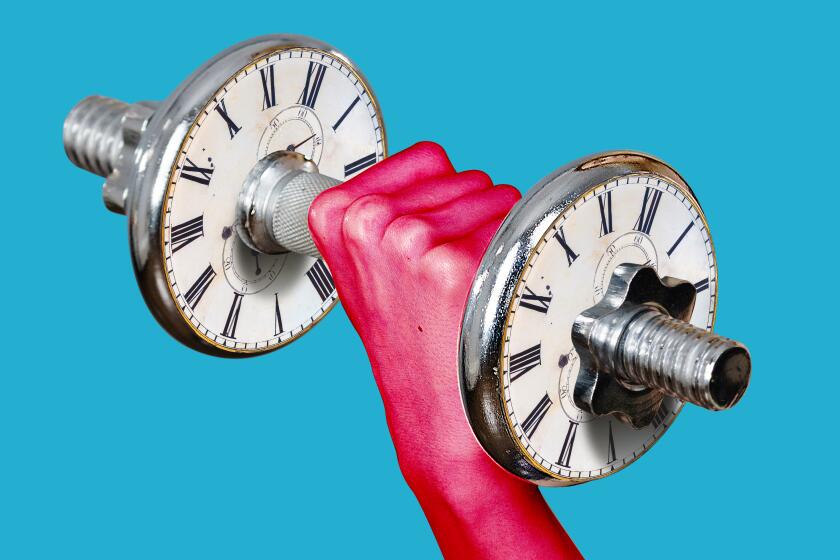Fashion trends: Some of the best knitwear looks are coming out of L.A.

One day in late August, in the final stretch of summer, Katie Holmes stopped internet traffic when she stepped out in New York City dressed in a sumptuously sleeved cashmere cardigan. Buttoned haphazardly at the navel and draped off of a shoulder, it revealed not just a sweep of collarbone and a peek of midriff but a matching cashmere bralette in the same crisp shade of barley.
The actress’ look caused a social media frenzy. All weekend, international fashion publications from Vogue to Grazia created “shop the look” features. Instagram feeds jammed with the image. “I saw Katie Holmes wearing a cashmere bra so I bought a cashmere bra,” read Dubai-based Savoir Flair’s caption, just after the bra in question, Khaite’s cashmere Eda Bralette, sold out within an hour despite costing $520.
Holmes had unofficially kicked off what the fall runways deemed the season of ambitious knitwear. If sweaters for fall sounds like an eye-rolling suggestion, think again. These are no mere bourgeois crewnecks meant to bolster wardrobes against dipping temperatures but weaves of wool, cashmere and upcycled cotton in constructions so complex and executions so luxurious, they only narrowly meet the categorical requirements of a sweater.
Take, for example, Joseph Altuzarra’s hybrid confections for his 10th-anniversary collection, in which a Fair Isle yoke gives way to a zebra-print coat, cable-knit sleeves flank biker jackets and blazers and fisherman knit vests transform into glistening plissé lamé skirts in silver and gold. Or the sophisticated knits that define Céline alumnus Daniel Lee’s debut for Bottega Veneta. Also, British designer Jonathan Anderson served up unencumbered femininity in sweaters of every weight (heavy-ply austere gray tunics, gossamer-thin ruffled sweater dresses, and paisley and striped sweaters punkishly braided, belted or knotted) at his label JW Anderson’s fall/winter show.
In the midst of political, economic and environmental anxiety, the desire to cloak oneself in temperature-controlled wardrobes of the softest materials seems the most natural self-soothing response. But it’s not the sweater revival’s only impetus. The seemingly unprecedented interest in knitwear has been building in Los Angeles for years.
Among L.A.-bred or -based designers, the groundswell began in 2008, the year Rodarte founders Kate and Laura Mulleavy released cobwebby twin sets made with loose weaves of threads so delicate they threatened to disintegrate on the wearer. It was also the year that fashion outsider Greg Chait shipped his first collection of Baja sweaters upgraded from their head-shop brethren by hand-knit cashmere so exquisite, they would go on to win the designer the CFDA/Vogue Fashion Fund award in 2012, beating out the better-known Wes Gordon and Tabitha Simmons.
Launched alongside the financial crash, Chait’s brand, the Elder Statesman, experienced unlikely success, which the designer credits to the unwavering value of his material of choice, cashmere. “It’s measurable! It’s like gold — there are levels,” said Chait. “24-karat gold is a lot more pure than 18-karat gold. Cashmere is measured by micron count.” Chait’s sweaters are hand-knit and hand-dyed at his new 20,000-square-foot downtown L.A. factory with the world’s best cashmere, sourced from India and Italy. The results are seemingly straightforward pieces with familiar themes (tie-dye, the California flag, a head-fake “Marlboro” logo that actually reads “Meditate”) that carry unmatched value you can feel and see — especially in the price tag. An Elder Statesman sweater can cost upward of $2,000. “In a world where everything’s so confusing and you don’t know what anything is, people want something they can understand,” said Chait.
People also want something they can wear — often. For all of the flash-in-the-pan glitz in today’s fashion, it’s the practical pieces that women respond to en masse. The Elder Statesman was borne of Chait’s love of cashmere, but it’s the sweaters’ relevance to their wearers’ lives that kept him, and soon others, churning them out. “It’s dry here. We’re in the desert. For at least 300 days a year, you need a sweater,” said Chait. “We don’t have overcoats in California, so a sweater is a really versatile piece.”

Catherine Holstein, the designer behind Holmes’ viral “bra-digan,” could be pinned with a similar inspiration point: Year after year, the California-born designer’s collections elevate the staples of a West Coast wardrobe (denim, shirting and sweaters) as do Mary-Kate and Ashley Olsen’s minimalist looks for The Row. The cropped V-neck cashmere cardigan the brand launched in 2018 became a similarly viral success when it was worn by fellow Angeleno Bella Hadid.
This is the city that birthed the cashmere sweatsuit, popularized by local designers high and low, including Baja East and Monrow, and the celebrities who fly in them. And the native urge to wear sweaters is not lost on newcomers: When vintage collector and street-style star Natalie Joos arrived in L.A. in 2016, she discovered an insatiable yen for the perfect fitted layering piece. Vintage Courrèges sweaters came close but they were “too short, not stretchy enough, and a little bit scratchy,” said Joos. After a year of searching, she set out to make some for herself under the label JoosTricot: peachskin (a supple blend of silk cotton and nylon plated in Lycra) mock turtlenecks, T-shirts and long-sleeve crewnecks made to stand on their own or sneak beneath a dress, blazer or shirt. “I think those sweaters are perfect for L.A. because it does get chilly — you can still be sexy but you’re covered,” she said.
“Knitwear is timelessly Californian,” agreed Katherine Kleveland, cofounder of Dôen, the brand favored by Topanga supermodels, celebrity doulas and rock-star royalty. Dôen has come to define the coastal Californian aesthetic to the international style set — particularly with the trademark chunky sweaters they turn out and sell out of each season. This fall’s oversized alpaca cable-knit cardigan in an earthy shade of cinnamon has already sold out, with a cropped, pompom-smattered mint green version set to drop shortly. “We just design what we want to wear,” said Kleveland of Dôen’s design ethos.

Sweaters from Dôen, the Elder Statesman, Khaite, the Row and JoosTricot are interchangeable season to season, with each designer’s collections blending seamlessly into one cohesive aesthetic. It’s an enticing concept in amongst the ugly truths of fast fashion. “I’m so allergic to doing something and moving on from it and never seeing it again,” said Chait whose point of pride lies in making products that will last aesthetically and physically. “We’re not making clothes for the sake of making clothes,” echoed Dôen cofounder Margaret Kleveland. “It’s this freedom of not having to exist in that trend cycle.”
How they’re made also speaks to their luxury. While big businesses scramble to attract Gen Z consumers with efforts to humanize the production and distribution of their goods, both the Elder Statesman and Dôen have set a new bar for transparency. These labels often document and publish every aspect of their production. “We’re super thoughtful and intentional in our sourcing, partnering with sources and producers who share our values,” said Katherine Kleveland. Dôen produces sweaters in Peru, knitted by a group of local women artisans who use alpaca wool from animals that are protected by the government. “It’s only shorn once a year,” added Margaret Kleveland. “The quality of raw materials and integrity of the people doing the work is at the highest level in Peru.”
More to Read
Sign up for The Wild
We’ll help you find the best places to hike, bike and run, as well as the perfect silent spots for meditation and yoga.
You may occasionally receive promotional content from the Los Angeles Times.










